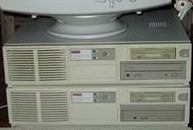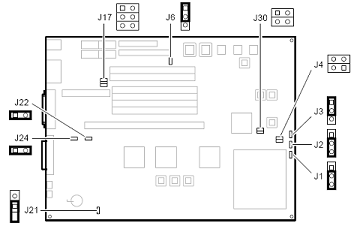
CPU: one 64bit Alpha/AXP 21064 CPU at 100MHz, 166MHz or 233MHz
Video: none onboard
Max Ram: up to 384MB
Chassis: Desktop
bus: 2 PCI/ISA, 1 ISA

Menu:


The AlphaStation 200 comes in a low-profile desktop case using an Alpha EV4 CPU at either 100MHz, 166MHz or 233MHz. It has one external 3.5" drive bay, one 5.25" drive bay, and two internal 3.5" bays for fixed disk drives.
Unlike previous Alpha workstation models (and VAXstations, DECstations) which used the TURBOchannel bus, the DECstation 200 uses PCI and ISA. It uses standard PC-style 72pin true parity (Nx36) 70ns memory SIMMs
Some suggest that the AlphaStation 200 is half-flash (can only have either ARC or SRM firmware loaded - not both) while others suggest it is full flash (has both ARC and SRM firmware loaded). One such discussion can be found here (comp.os.vms on google groups). It seems that the AlphaStation 200 comes in both versions possibly depending on age. A number of usenet discussions state that the ones sold from onsale.com in the late 90s are half-flash. Full flash systems should have two 28F020 Flash ROMs on the system board. Half flash machines will only have one.
The riser board contains the DECchip 21040 ethernet interface. A cable is run from the end of the riser board out to another board mounted next to the sound card. This board provides the 10baseT (UTP) and 10base2 (BNC) interfaces.
The AlphaStation 200 series comes with a small version of the Microsoft Sound Card plugged into a single ISA slot directly on the motherboard separate from the riser board containing the normal PCI/ISA/EISA slots. The ISA slot used by the sound card is not a normal one as can be seen in the images of the device below. The option number for the device is PBXJA-AA.
The top cover is held on with a key lock. This can make getting into the machine a bit difficult if the key is missing. However, the lock can be dealt with by inserting a flat-headed screwdriver under the edge of the cover at the points shown below and twisting to the left. This pulls the cover towards you and to the left sliping the cover past the lock.
![[Lock circumvention diagram]](images/circumvent-lock.jpg)
Try this at your own risk - it worked fine for me but it might not work for you. I have done this to one of my AlphaStation 200s with no damage to the case. Once I had the cover off I removed the lock so that it would not be a problem again. My other AlphaServer seems to have already had its lock adjusted as can be seen in the images below - the lock is in the locked position but is pointing the wrong way. The images below show some views of the lock:
More suggestions can be found at http://groups.google.co.nz/group/comp.sys.dec/msg/c5be5ab22aefa484?hl=en&dmode=source
Should a firmware upgrade fail for some reason, the systems firmware can be started from floppy disk. The firmware update site describes how to create such a firmware floppy disk. To make the system start the firmware from a floppy disk, set J2 on the motherboard to the 1-2 position. The 2-3 position (default) makes the system start the firmware from the Flash ROM.

J3 on the motherboard (see diagram above) controls the action of the reset button. If the 1-2 position is selected (default), the front panel push button causes a reset. If position 2-3 is selected, this button becomes a halt button.
Like many RISC machines, these can be operated via their serial port. This is controlled by the console SRM environment variable. Set it to serial to make the machine always use a serial console attached to its primary serial port. Set it to graphics to use a framebuffer console. If the machine is configured to boot using its framebuffer console but it detects there is no keyboard present it will default to using the serial console anyway. Chances are your machine may use a ZLXp for its framebuffer/video card. If so, the ZXLp information page and the ZXLp Configuration Notes page may be of interest.
Images of my two systems can be found here and here.